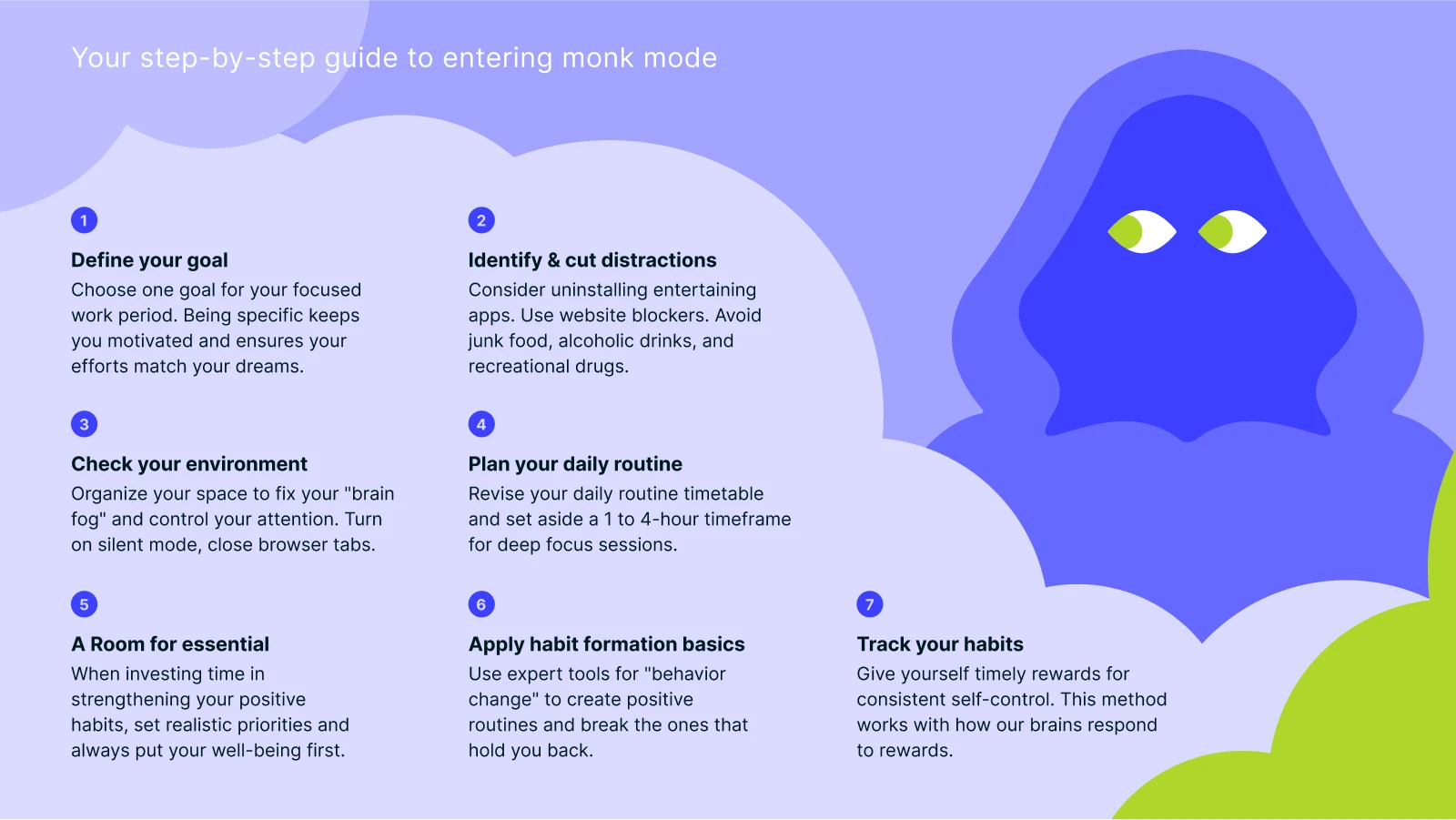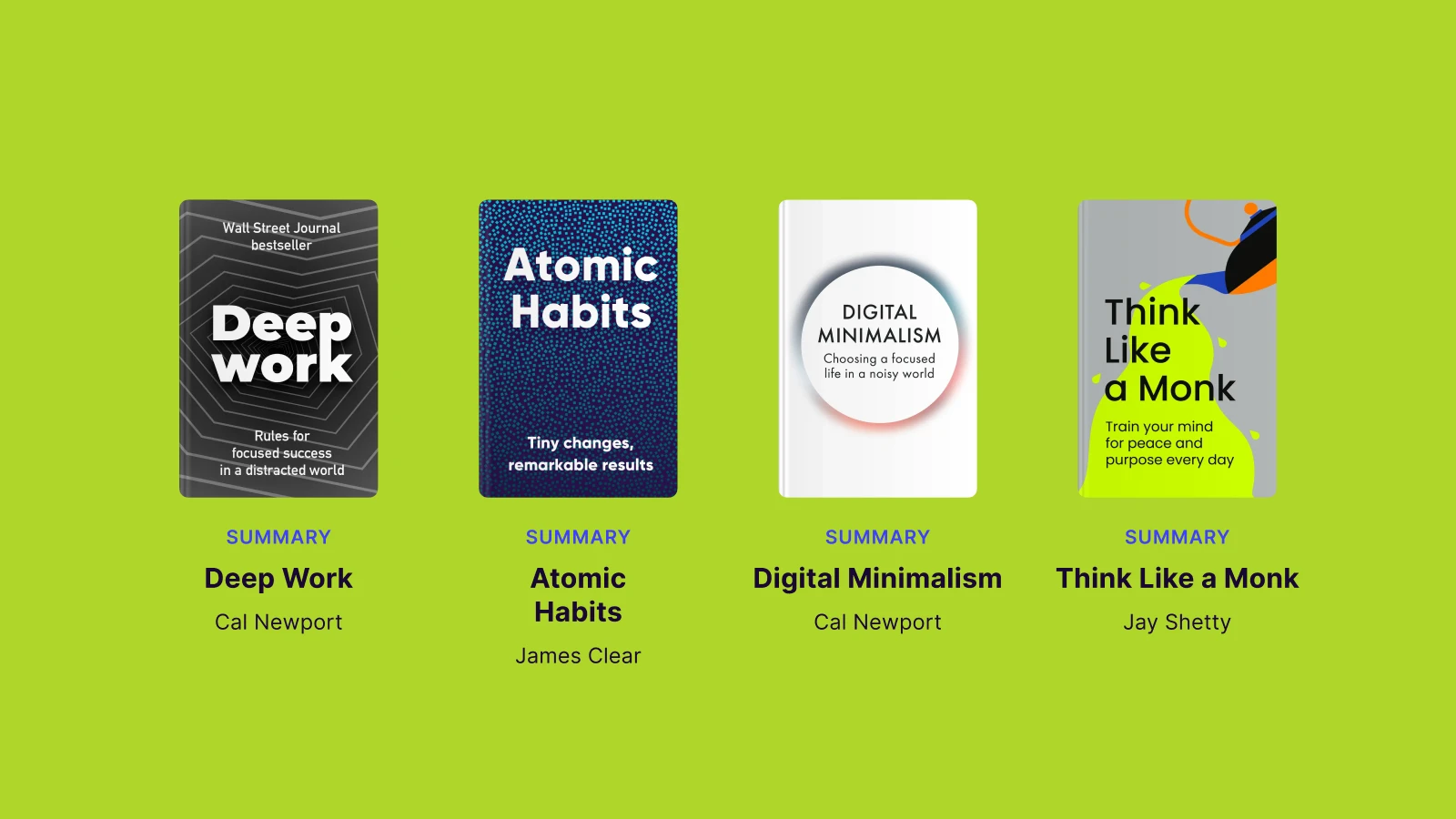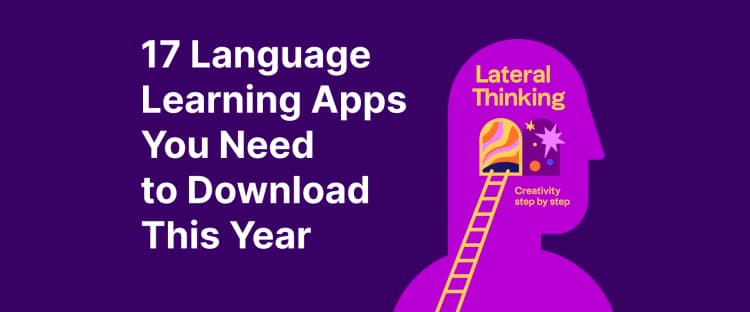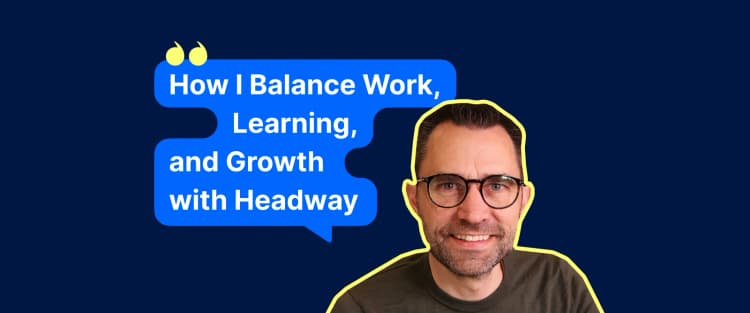What is monk mode? Definition and origins
Monk mode refers to a specific time when a person reduces distractions to focus intensely on a single task or goal. It helps you be more productive and self-disciplined, emulating the quiet lifestyle of monks. The main goal is to optimize your productivity and stay dedicated to personal growth.
The concept of monk mode was created in monasteries. Historically, they have always served as places of prayer and productivity, though perhaps not in the way we understand them today. When monks retreat from the normal distractions of everyday life, they spend most of their days in spiritual meditation and deep focus.
St. Benedict described the monks' daily schedule and specific times for prayer, work, study, and rest. The well-known Latin phrase "ora et labora," meaning "pray and work," probably best captures this way of life.
While the concept of "monk mode" isn't new, it has gained popularity recently, especially among younger business owners. In 2023, business magazines started featuring it as a game-changing tool for getting things done.
Today, "monk mode" usually involves setting aside specific periods — from a few minutes to several months — dedicated to building good habits and sharpening your focus. Many people use digital tools like apps or browser extensions to help limit distractions during these focused times.
The psychology behind monk mode: A detox for mental clarity
In today's world, distractions from phones and digital devices make it incredibly hard to concentrate. A never-ending stream of notifications distracts us, often leading to stress that can develop into anxiety and panic attacks.
Think of it like a computer trying to run too many programs at once — everything slows down and starts glitching. Our divided focus reduces our ability to get things done effectively and can lead to more mistakes.
Deep work: Why it helps you focus
Cal Newport's idea of "deep work" is all about tackling challenging tasks without any distractions. This type of work pushes your brain to its limits and actually helps you improve your skills.

"Shallow work" covers more manageable tasks you can do while distracted, such as answering emails, responding to LinkedIn DMs, or scrolling through TikTok. Spending too much time on shallow work weakens your ability to do deep work, a valuable skill in a digital era.
Deep work isn't just something you're born with; it's a skill anyone can build with practice and the right environment. It has proven invaluable in tackling the so-called "attention residue," those lingering thoughts that bug you when you jump between tasks. Working without interruptions helps you manage this mental clutter and stay productive.
Dopamine detox to clear up your mind: How it helps
The "dopamine detox" is a popular idea suggesting that you can take a "break" from dopamine. This neurotransmitter is a chemical in the brain that helps with movement, memory, pleasure, and other vital functions. Of course, we can't really stop our brain from producing it; the detox part is essentially just a misnomer.
The goal of "dopamine fasting" is not to lower your brain activity. Instead, it aims to discourage certain behaviors that give your brain too much dopamine. This excess can lead to impulsive or addictive habits.
Dr. Cameron Sepah, a psychiatrist and professor, introduced this concept to help people reduce dopamine spikes from social media scrolling, gaming, and eating junk food. The suggestion is that working on self-control over those things will break unhealthy habits and reset your brain and the way it responds to chemical rewards.
However, if taken to the extreme, this method can cause depressive states or even nutritional issues. Instead of going overboard, practices like mindfulness are more effective for balancing dopamine levels and improving mental clarity.
The key is to become less impulsive in your personal and professional life. Stay alert to fleeting self-help trends and stick with reliable science. This way, you can achieve lasting success that will stick.
Top benefits of monk mode
Embracing monk mode brings positive changes that go beyond just checking items off your to-do list. It improves your mental well-being and teaches you absolute self-control over your desires and impulses.
Boosts focus: Monk mode helps you learn how to maintain focus effortlessly by turning off distractions, clearing your mind, and reducing hurry and busyness.
Improves emotional control: By removing attention-suckers and concentrating on specific deadline goals, monk mode helps you hit key milestones faster.
Helps you reach goals faster: The "monk mode" philosophy simplifies your life, which protects your mental health and sleep quality so you can work better.
Monk mode is more than just getting things done; it's about excelling at self-control. Pushing aside feelings when necessary helps you make more rational choices. Focusing better makes you naturally feel less stressed and think more clearly.
How to enter monk mode: Your step-by-step guide
The following 7-step guide walks you through all the steps you need to take to increase your chances of success with monk mode.

Step 1: Start by defining your goal
Choose one specific goal for your focused work period. This could be about a business start-up launch, learning a new skill, mastering a new foreign language, or getting in shape. If your goal is vague, you may not get the desired results. Being specific keeps you motivated and ensures your efforts match your dreams.
Step 2: Identify and cut distractions in your digital and everyday life
Consider uninstalling entertaining apps. Use website blockers. Avoid junk food, alcoholic drinks, and recreational drugs. Choose your social events wisely, avoid time-wasting activities, and save your mental energy for focused work by breaking the instant gratification cycles.
Step 3: Ensure that your physical and digital environment inspires you
Organize your space to fix your "brain fog" and control your attention. Tidiness and individual design create a strong link between your workplace and focused work time. Turn on silent mode, close unnecessary browser tabs, and keep your digital and physical spaces clear and clutter-free.
Step 4: Plan your daily routine (to include the deep work sessions)
Revise your daily routine timetable and set aside a 1 to 4-hour timeframe for deep focus sessions to complete important tasks without being interrupted. Include work, breaks, and limited social media in your schedule. This will save you hours and activate your brain's concentration center (prefrontal cortex).
Step 5: Make room for essential practices in your timetable
When investing time in strengthening your positive habits, set realistic priorities and always put your well-being first.
Meditate and practice mindfulness: Dedicate at least 30 minutes daily to calm your mind and enhance your cognitive skills.
Exercise regularly: Train your body to boost serotonin and promote delayed gratification.
Keep a one-line-a-day journal: Track your feelings and moods and reflect on your progress.
Read with purpose: Set aside time for meaningful reading.
These practices are crucial for building mental and physical resilience, supporting sustained focus and self-awareness in achieving monk mode.
Step 6: Make sure to apply habit formation principles
Use expert tools for "behavior change" to create positive routines and break the ones that hold you back.
To build good habits, make them clear, appealing, simple, and rewarding. For instance, laying out your workout clothes reminds you to exercise, and starting with just five minutes of meditation keeps it enjoyable.
To break bad habits, make them less appealing, difficult, and unfulfilling. Try deactivating Instagram or blocking addictive websites. Don't feed the life you don't want to live; think one step ahead.
Integrating small, daily habits makes positive changes feel natural, transforming "monk mode" into a lifestyle.
Step 7: Give yourself feedback to track and control your habits
Give yourself timely rewards for consistent self-control. When you slip into self-sabotage, counter it with temporary limits. This method works with how our brains respond to rewards, turning behavior into an automatic one.
Communicate your boundaries while following the guide
When you take on the monk mode challenge, you should let your friends, family, and coworkers know the personal boundaries you're going to keep. This will be very helpful and assist you in staying focused. When taking a step back from socializing, you'll need understanding and support from your close ones.
Monk mode variations: How you tailor your practice to your life
The following table illustrates how monk mode can fit various lifestyles. You don't need strict rules; you can adapt the principles to suit your needs. This flexibility is important because going all in isn't always doable; but consistent efforts, even when small, can lead to meaningful improvements, regardless of how busy you are.
Types and examples of monk mode for different lifestyles
| Variation (from easier to harder) | What is it? | If you are a student | If you are a parent | If you are an entrepreneur |
|---|---|---|---|---|
1. Monk of the hour | Set aside a few hours each day just for you. | Spend 1–2 hours in a library. Turn your phone off to get in the zone. | Use early mornings to start with personal growth projects. | Save a couple of hours (before or after work) to focus on your side business. |
2. Monk of the weekend | Go into monk mode for the whole weekend. | Get ready for focused study sessions on weekends to close all your deadlines. | Leave the kids with their grandparents and take time to focus on your personal goals. | Engage in intense work sessions to promote your projects. |
3. Monk of the week | Do monk mode on weekdays and enjoy social time on weekends. | Keep your weekdays focused. Enjoy downtime on Sundays. | Balance by dedicating weekdays to focused productivity and reserving weekends for your family. | Maximize your business productivity 5 days a week and give your mind some rest on weekends. |
4. Intermittent monk | Go for longer (one week to six months), intense work sessions. Then take time to recharge. | Dedicate a month to preparing for your exams, then treat yourself to a refreshing short-term break. | Start a three-month career-change journey or a home project. After that, it's time for the "relax phase." | Get ready for a six-month sprint to launch a new skill or product. Then, refocus and regroup. |
5. Seasonal monk | Channel your focus to match the season's energy: winter, summer, spring, or autumn. | Maximize your study potential during cold seasons. Spend more quality time inside. | During the colder seasons, initiate colorful indoor projects or master new skills. | Upgrade your productivity by intense work sessions (software skills development, etc.) during cozy seasons. |
6. Forever monk | Ensure your "unwavering dedication" routine includes quality breaks. | Strive to create a focused study routine while taking time for leisure activities. | Incorporate self-discipline into your daily family and work life to make both purpose-driven. | Pursue your business and personal goals intentionally, but take care of yourself by taking breaks. |
Related concepts and best books to immerse yourself in your monk mode

The ideas behind monk mode come from various self-improvement schools. Experts such as Cal Newport, James Clear, and Jay Shetty (aka a "Hollywood friend") provide tips on building unbreakable habits and pushing past your limits. You can find summaries of their books in the Headway app and begin deep focus optimization.
'Deep Work' by Cal Newport: Focus without distraction
Cal Newport's 'Deep Work' refers to the ability to focus intensely on challenging tasks without distractions, a skill that Cal Newport emphasizes is crucial yet rare.
"What we choose to focus on and what we choose to ignore — plays in defining the quality of our life."
2. 'Atomic Habits' by James Clear: Build unbreakable habits
'Atomic Habits' by James Clear encourages the idea of getting "1% better each day" and building "effective systems" relying on "behavior change laws."
"Every action you take is a vote for the person you wish to become… as the votes build up, so does the evidence of your new identity."
3.' Digital Minimalism' by Cal Newport: Befriend the tech progress
Cal Newport's 'Digital Minimalism' encourages readers to be technology minimalists. He recommends focusing our time online on key activities matching our core values.
"'All of humanity's problems stem from man's inability to sit quietly in a room alone."
4. 'Think Like A Monk' by Jay Shetty: There is more to life than a daily routine
In "Think Like a Monk," Jay Shetty shares his experiences as a monk and how he discovered a deeper meaning in life through helping others; check out his Spotify podcast, "On Purpose," to learn more.
"Saying whatever we want, whenever we want, however we want, is not freedom. Real freedom is not feeling the need to say these things."
5. 'The Ruthless Elimination of Hurry' by John M. Comer: Spend your days with no rush
In 'The Ruthless Elimination of Hurry,' John M. Comer discusses "hurry sickness" and how the data and soft tech revolution have taken it to new, terrifying extremes.
"Your life is no more than the sum of what you gave your attention to. That bodes well for those apprentices of Jesus who give the bulk of their attention to Him and to all that is good, beautiful, and true in His world."
6. 'Can't Hurt Me' by David Goggins: Push past limits
In 'Can't Hurt Me,' David Goggins motivates his readers to enter monk mode and "train" the habits and character they want to have.
"In the military, we always say we don't rise to the level of our expectations, we fall to the level of our training."
Common challenges when you try monk mode (and how to solve them)
Monk mode works by offering both benefits and challenges. As the authors explain, actual change happens when your habits become part of who you are. Instead of saying, "I'll try out monk mode," you'd soon start thinking, "I've become a focused, disciplined person who knows how to control procrastination urges."
While building your new self, prepare to face the swarm of internal and external temptation from the modern world that pulls you back. Below are some examples of those challenges and quick solutions.
How to handle challenges coming from within you
Sometimes, monk mode brings certain emotions to the surface that you would typically avoid. If this happens, see it as a chance for healing and growth. You can improve your self-awareness by journaling, self-reflecting, or seeking professional support.
| Internal problem | Quick solution |
|---|---|
1. Problem of mental and physical impulses: Those in monk mode need some time to get used to decreased brain stimulation (screen time leading to brain rot). | Solution: One effective method for handling these cravings is the 10-minute rule (before giving in to distractions). You can also try the Pomodoro technique. |
2. Problem of overthinking the past: When the mind starts lacking external stimuli like video games, it may fixate on past events or fantasies and stress you out. | Solution: To counter this, resist the urge for digital stimulation. Journaling can help as you record your distractions, feelings, and triggers. |
3. Problem of feeling pessimistic: Going into monk mode, where you focus intensely on self-improvement, might upset and make you anxious as you face unresolved feelings. | Solution: Acknowledge that these emotions are temporary and focus on the long-term benefits. Consider help from a mental health professional (monk mode isn't a substitute for it). |
How to deal with the troubles attacking you from the outside
Monk mode can also cause external factors to wear you out. At this time, you would need a friend's support and your loved ones to cheer you on along the way.
| External problem | Quick solution |
|---|---|
1. Problem of extreme isolation and burnout: Spending too much time in monk mode right away can cause extreme isolation and burnout. | Solution: Keep in touch with friends and family and communicate your boundaries. Take regular breaks to balance intense work with rest. |
2. Problem of mistaking monk mode for unhealthy hustle culture: Monk mode focuses on disciplined, high-quality work, unlike the relentless grind of hustle culture. | Solution: Rest more. Take cold showers. Cognitive fatigue from deep work is natural, and recovery is necessary for physical health and sanity. |
Sustain your deep focus long-term with Headway
By minimizing distractions, cultivating supportive environments, and prioritizing well-being, anyone — be it students, entrepreneurs, or regular folks — can succeed. A key part is to face psychological hurdles and burnout with moderation and a touch of self-compassion.
If you want to learn more about effective, practical tools for personal development, mental health, and emotional resilience, the Headway Team has got you covered! The app is ready to equip you with curated, personality-tailored reading lists like "40 must-read self-improvement books for growth and achievement." Small but consistent changes go a long way.
FAQs
How long should monk mode last?
The standard amount of time in a monk mode ranges between a few hours and several months. For specific goals and consistent progress, the option of one to three months works best.
Can I still have social interactions during monk mode?
Yes, but make sure your interactions are meaningful. While some people may prefer less socializing, telling friends and family about your monk mode is helpful so they know what to expect
Is monk mode for everyone?
Practicing monk mode can help many people, but it might be too intense for some. Introverts might find it easier than extroverts. It's also not a replacement for professional help; beginners should ease into it.
What if I slip up and break the rules?
Relapses happen. They are rarely avoidable, especially over a long period of time. Take it as part of the journey. Mistakes aren't reasons to give up. Take a moment to reassess and refocus as needed.
Can I change the rules for my monk mode?
Yes, you can update monk mode to suit your needs. While the core principle stays the same, you can alter the details to meet your personal circumstances.













